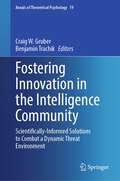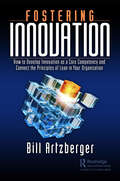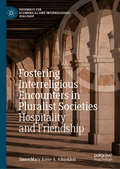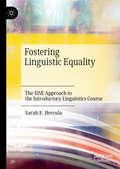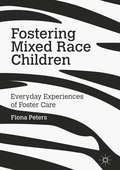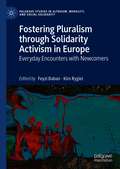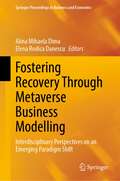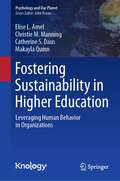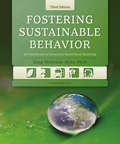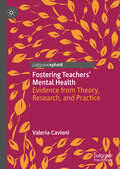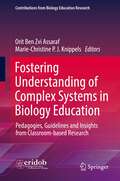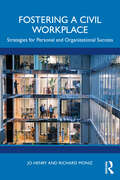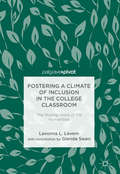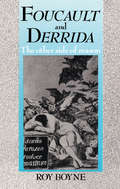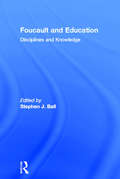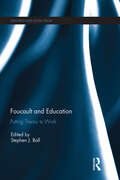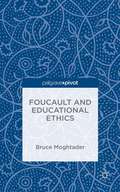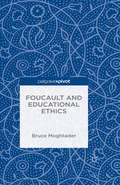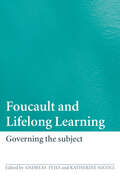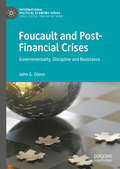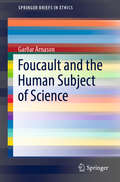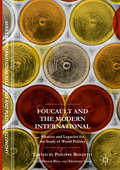- Table View
- List View
Fostering Friendship: Pair Therapy for Treatment and Prevention (Modern Applications Of Social Work Ser.)
by Robert SelmanA great number of children and adolescents face a world of violence and isolation. In this book, the members of the Group for the Study of Interpersonal Development at the Harvard Graduate School of Education and the Judge Baker Children's Center in Boston describe in detail an innovative intervention and prevention method, pair therapy, that is designed to address these issues by helping children develop healthy interpersonal relationships. Pair therapy is a relationship-oriented treatment modality that addresses the social context of the difficulties encountered in growing up in today's world. This approach has been developed not only as a therapeutic intervention in day and residential treatment centers but also as a prevention method that can be used in public schools, day care centers, and other contexts. This practical volume meets the demand for an accessible, hands-on guide to the pair method. The theoretical foundations of the approach are also presented in an accessible fashion here. The techniques described in this book model a relationship-building process between an adult professional and two children. This process replicates the social relations that happen naturally in healthy and happy interactions and long-term relationships among well-cared-for children in safe and secure communities. This book will be useful for a number of disciplines that deal with younger children and adolescents: social work, education, school and group therapy, and human development. It offers educators, therapists, and other practitioners in a wide variety of settings the opportunity to learn how to develop a pair therapy program. It will also be an indispensable tool in the libraries of mental health practitioners who counsel youth beyond ordinary clinical treatment.
Fostering Innovation in the Intelligence Community: Scientifically-Informed Solutions to Combat a Dynamic Threat Environment (Annals of Theoretical Psychology #19)
by Craig W. Gruber Benjamin TrachikIn response to the increasingly ubiquitous, asynchronous, and pervasive use of cyber technology in everyday life, unique threats to cybersecurity (CS) have emerged requiring innovative and systemic solutions. Of the potential threats, Ubiquitous Technical Surveillance (UTS) presents one of the most acute generalized vulnerabilities facing the broader Intelligence Community (IC), Department of Defense (DoD), and United States Government. While security systems and networks have attempted to adapt to meet these evolving threats, internal organizational structures, culture, and human behavior often lag behind due to the inherent challenges in changing these dynamic variables. It is crucial that scientific disciplines identify systemic and innovative behavioral countermeasures that are informed by sub-disciplines of the psychology and CS literature. Innovative strategies involve collaboration amongst experts from the domains of social psychology, game theory, Bayesian statistics, and the IC, which will be discussed in-depth. A special issue that pulls from cross-disciplinary professionals will have a broad impact for the IC and DOD eliciting wide readership and spurring needed innovation._____________________________________________________________________"Cultivating a culture of innovation, though difficult, is important for any enduring organization. It's downright essential for the US Intelligence Community, which must stay one step ahead of adversaries on surveillance technologies and tradecraft to be effective. This collection of articles brings together insightful research and analysis from diverse domains, moving us closer to the deeper appreciation of innovation and culture that is so urgently needed."David Priess, Ph.D., former Central Intelligence Agency officer and author, The President's Book of Secrets
Fostering Innovation: How to Develop Innovation as a Core Competency and Connect the Principles of Lean in Your Organization
by Bill ArtzbergerWhile innovation can be defined in many ways, the author sees it as a process. It is not the sudden eureka moment in the middle of the night, nor is it a clear and linear path towards a final destination. Instead, it involves a strong sense of creativity and curiosity. An innovative mind has a natural inclination towards out-of-the-box thinking. It involves a willingness to try something new, without fear or judgment, to develop something no one else has ever articulated. While the mindset comes naturally, it requires fuel to keep it running. Innovators are voracious readers and researchers. They feed their mindset all of the fuel it needs to stay informed and relevant in their field. Many of the same things can be said for the Lean mindset. Lean management doesn’t happen overnight, and it is very rarely a clear and linear path to true Lean thinking. Some might consider Lean a subset of innovative thinking, while others see it in reverse. Regardless of the relationship’s directionality, one thing is certain: You cannot have one without the other. This book follows John Riley, the CEO of a medium-sized valve company just outside of Pittsburgh, Pennsylvania, who will stop at nothing to create an innovative work environment. Through the ups and downs of his journey, he learns a number of Lean and innovative skills, strategies, and mindsets to help him build the business he’s always envisioned for himself. Throughout the book, you see examples of both strong and poor innovative leadership skills demonstrated by each of the main characters. The key messages are ones that help leaders build and access a mindset insistent on continuous improvement. Leadership techniques and abilities that bolster creative thought and problem-solving are the most successful throughout this book. To be truly innovative, you can never stop driving the learning process. For this to happen, leaders need to recognize when there is a need for a change or improvement. This is the beauty of the marriage between Lean and innovation: They both require continuous learning and growth. The desire to improve is only one piece of this equation, however. The other is the willingness to act. Without both of these factors, true innovation will always be out of reach.
Fostering Interreligious Encounters in Pluralist Societies: Hospitality and Friendship (Pathways for Ecumenical and Interreligious Dialogue)
by SimonMary Asese AihiokhaiThis book calls attention to ways of fostering dialogue among members of different religious traditions in an era of cultural and religious pluralism. To achieve this, the author analyzes the results of an ethnographic study of Ihievbe, a town in Midwestern Nigeria that is religiously pluralistic. Emphasis is given to hospitality and friendship—two key relational, cultural, philosophical, and theological virtues—as tools for constructing healthy interreligious dialogue that is relevant for our times. A critical study is done on the importance of these two dialogical virtues in the religious expressions of Roman Catholicism, Islam, and Ihievbe Traditional Religion. Preference for ethnographic studies is based on stressing the relevance of context in articulating useful practices of interreligious dialogue. Finally, the book articulates ways the fruits of interreligious dialogue can be celebrated in the liturgical rituals of each religion, especially the three religions that are addressed here.
Fostering Kinship: An International Perspective on Kinship Foster Care (Routledge Revivals)
by Roger GreeffFirst published in 1999, this work draws together a multi-national collection of papers, and aims to stimulate the development of policy and practice in this often neglected area. It aims to offer examples of good social work practice, informed by relevant theoretical insights; to give a voice to kinship foster carers and young people so that practice can be informed by an understanding of their experience; to share the results of current research; to highlight issues for policy makers; and to place the issues in the wider international context of developing social policy, ideology and social change. There are contributions from the UK, Poland, the Netherlands, Belgium, Ireland, the US and New Zealand.
Fostering Linguistic Equality: The SISE Approach to the Introductory Linguistics Course
by Sarah E. HerculaThis book offers one possible solution in the pursuit of linguistic equality by exploring how the Structural Inquiry of Stigmatized English (SISE) approach to linguistics pedagogy can be used to empower linguistics students and researchers as ambassadors for change. By using stigmatized varieties of English (including African American English, Chicano English, and Appalachian English) as the primary linguistic data analyzed through detailed structural analysis, the SISE approach fosters linguistically principled and pluralistic language attitudes among students, as evidenced by the author’s own empirical research in applying the method. This book not only advocates for linguistic equality but also provides teachers and researchers with the tools they need to counteract prejudicial attitudes and disinformation about language both in and outside the classroom. It will be an essential resource for linguistics teachers, applied linguists, curriculum developers, students and scholars of language attitudes and language variation, and anyone seeking more information about the relationships between diversity, (in)equality, and language.
Fostering Mixed Race Children
by Fiona PetersThe 'mixed race' classification is known to be a factor of disadvantage in children's social care and this fastest growing population is more likely than any other ethnic group to experience care admission. How does knowledge of 'mixedness' underpin policy and practice? How, when and why is the classification 'mixed' a disadvantage? Through narrative interviews with children currently in foster care, Fostering Mixed Race Children examines the impact of care processes on children's everyday experiences. Peters shows how the 'mixed race' classification affects care admission, including both short and long term fostering and care leaving, and shapes the experiences of children in often adverse ways. The book moves away from the psychologising of 'mixedness' towards a much-needed sociological analysis of 'mixedness' and 'mixing' at the intersection of foster care processes. This book will be of interest to academics and practitioners working with families and children. Peters presents a child-centred narrative focus and offers unique insights into a complex area.
Fostering Pluralism through Solidarity Activism in Europe: Everyday Encounters with Newcomers (Palgrave Studies in Altruism, Morality, and Social Solidarity)
by Feyzi Baban Kim RygielThis edited collection brings together academics, artists and members of civil society organizations to engage in a discussion about the ideas of living with others, through concepts such as cosmopolitanism, solidarity, and conviviality, and the practices of doing so. In recent years, right wing and populist movements have emerged and strengthened across Europe and North America, rejecting the value of cultural, ethnic and religious plurality. Governments in Europe and North America are weakening their commitment to the international refugee regime, erecting new barriers to entry. Even as governments fail to accommodate growing pluralism, however, civil society initiatives have emerged with the aim of welcoming newcomers, such as migrants and refugees, and finding alternative ways of living together in diverse societies. Motivated by a desire to show solidarity, these initiatives demonstrate enormous creativity in fostering pluralism in an environment that has largely become hostile to the arrival of newcomers. The contributions gathered here seek to explore such initiatives and the important work that they do in fostering ways of living together with others from diverse cultural and religious backgrounds. In focusing conceptually and empirically on discussions and examples of civil society initiatives, this book interrogates why, how and under what circumstances are some communities more welcoming than others.
Fostering Recovery Through Metaverse Business Modelling: Interdisciplinary Perspectives on an Emerging Paradigm Shift (Springer Proceedings in Business and Economics)
by Alina Mihaela Dima Elena Rodica DanescuThrough the lens of multi- and interdisciplinarity, this book highlights the potential of progress in cloud computing technologies, metaverse development, and digital transformation in charting a path to economic and social recovery, governance process and societal evolution enabling to tackle the global polycrises triggered by the Covid-19 pandemic in 2020. The book is an outcome of the 5th International Conference on Economics and Social Sciences, ICESS 2022, Bucharest, Romania.
Fostering Sustainability in Higher Education: Leveraging Human Behavior in Organizations (Psychology and Our Planet)
by Elise L. Amel Christie M. Manning Catherine S. Daus Makayla QuinnSustainability is one of the most critical challenges facing humanity. Changing Higher Education Institutions (HEIs) is crucial to overcoming that challenge because of their roles providing cutting edge knowledge and preparing our future citizens, workforce, and thought leaders. Many educational organizations are already leading the way toward sustainability, but a multitude of others still have substantial work to do. The field of Industrial/Organizational (I/O) psychology offers a wealth of knowledge about human behavior within organizations that can support the changes essential for moving toward sustainability. This book serves as a one-stop-shop for individuals intent on engaging their HEIs in sustainability, but who have little experience with organizational change or have encountered barriers to progress. It synthesizes the empirical literature and describes through accessible prose the psychological principles to encourage structural, procedural, social, and behavioral changes in support of a socially just and environmentally sustainable future.
Fostering Sustainable Behavior
by Doug Mckenzie-MohrTo attain a sustainable future, we must change many of our everyday actions. This completely revised and updated edition of Fostering Sustainable Behavior shows how community-based social marketing is key to overcoming barriers and resistance, and creating new social norms.
Fostering Teachers' Mental Health: Evidence from Theory, Research, and Practice
by Valeria CavioniThis book discusses teachers&’ mental health applying a whole-school approach. Addressing the current teacher recruitment and retention crisis that many countries in Europe are facing, the author discusses the stressors and challenges teachers experience regarding workload, behavioural management and engagement concerns, managing parental expectations, governance issues from governmental agencies, and access to appropriate mental health resources to mitigate some of these. A timely resource, this book explores protective factors for educators' psychological well-being, such as teachers' social and emotional competencies, as well as contextual determinants like the quality of staff relationships, teacher-student relationship, school climate, and school belonging. Its scope extends to practical applications of large-scale European school-based projects in this area, providing readers with evidence-based examples of successful mental health initiatives. Bridging the gap between theory and practice, the book equips educators, researchers, and policymakers with the knowledge and tools to effectively address and enhance teachers&’ mental health and well-being.
Fostering Understanding of Complex Systems in Biology Education: Pedagogies, Guidelines and Insights from Classroom-based Research (Contributions from Biology Education Research)
by Orit Ben Zvi Assaraf Marie-Christine P. J. KnippelsThis book synthesizes a wealth of international research on the critical topic of ‘fostering understanding of complex systems in biology education’. Complex systems are prevalent in many scientific fields, and at all scales, from the micro scale of a single cell or molecule to complex systems at the macro scale such as ecosystems. Understanding the complexity of natural systems can be extremely challenging, though crucial for an adequate understanding of what they are and how they work.The term “systems thinking” has become synonymous with developing a coherent understanding of complex biological processes and phenomena. For researchers and educators alike, understanding how students’ systems thinking develops is an essential prerequisite to develop and maintain pedagogical scaffolding that facilitates students’ ability to fully understand the system’s complexity. To that end, this book provides researchers and teachers with key insights from the current research community on how to support learners systems thinking in secondary and higher education. Each chapter in the book elaborates on different theoretical and methodological frameworks pertaining to complexity in biology education and a variety of biological topics are included from genetics, photosynthesis, and the carbon cycle to ecology and climate change. Specific attention is paid to design elements of computer-based learning environments to understand complexity in biology education.
Fostering a Civil Workplace: Strategies for Personal and Organizational Success
by Jo Henry Richard MonizFostering a Civil Workplace: Strategies for Personal and Organizational Success provides research-based solutions to promote a positive work environment. Focusing on internal dynamics, it explores aspects of communication, interpersonal interactions, management techniques, and organizational culture and oversight.While some work environments are productive and positive, many are not, with employees experiencing incivility, bullying, intimidation, and harassment. Recent developments, such as a shift towards home and hybrid working, can also contribute to this. This book promotes workplace civility in dysfunctional work environments by offering solutions, focusing on playing to personal strengths, which can be utilized by individuals, leaders, and the larger organization. Methods for improvement begin with individual interactions, such as handling a dispute or a difficult co-worker, and extend to online, interdepartmental, and organizational levels, examining ways to improve communication. Suggestions are offered for improving work connections and building empathetic relationships within teams and between departments to foster a civil and productive environment, through sharing, bonding, and encouraging coworkers. A review of positive impacts made possible by effective leadership includes concepts such as trust, authenticity, and adaptability, alongside guidance on navigating conflicts between employees, and an exploration of challenges experienced in middle management. Ideas regarding organizational culture and employer support include promoting active learning, wellness, and training opportunities, with strategies for employee development, and advice on code of conduct policies.Providing an accessible overview of solutions for workplace incivility to foster a more positive and dynamic workplace for all, this book will appeal to leaders and managers looking to create better workplaces, students of leadership and management, and employees struggling with toxic work situations.
Fostering a Climate of Inclusion in the College Classroom: The Missing Voice Of The Humanities
by Lavonna L. Lovern Glenda SwanThis book examines inclusion teaching at the college and university level. It establishes the importance of the Humanities disciplines and the use of qualitative analysis as a means of understanding and encouraging democratic materials and classroom organization. The first section of the text provides two primers for those unfamiliar with pedagogical history and theory. These primers are designed to give basic information and sources for additional study. They trace pedagogical influences from foundationism, neoliberalism, conflict, and critical theories to critical race theory, Red pedagogy, and decolonization theories. The second half of the book focuses on strategies to assist those attempting classroom inclusion. These chapters are designed to assist with practical ways in which inclusion can be advanced as well as strategies to assist junior faculty in the navigation of the politics of inclusive education.
Foucault and Derrida: The Other Side of Reason
by Roy BoyneThe writings of Michel Foucault and Jacques Derrida pose a serious challenge to the old established, but now seriously compromised forms of thought. In this compelling book, Roy Boyne explains the very significant advances for which they have been responsible, their general importance for the human sciences, and the forms of hope that they offer for an age often characterized by scepticism, cynicism and reaction. The focus of the book is the dispute between Foucault and Derrida on the nature of reason, madness and 'otherness'. The range of issues covered includes the birth of the prison, problems of textual interpretation, the nature of the self and contemporary movements such as socialism, feminism and anti-racialism. Roy Boyne argues that whilst the two thinkers chose very different paths, they were in fact rather surprisingly to converge upon the common ground of power and ethics. Despite the evident honesty, importance and adventurousness of the work of Foucault and Derrida, many also find it difficult and opaque. Roy Boyne has performed a major service for students of their writings in this compelling and accessible book.
Foucault and Education: Disciplines and Knowledge (Routledge Library Editions: Michel Foucault)
by Stephen J. BallFirst published in 1990, this book was the first to explore Foucault's work in relation to education, arguing that schools, like prisons and asylums, are institutions of moral and social regulation, complex technologies of disciplinary control where power and knowledge are crucial. Original and challenging, the essays assess the relevance of Foucault's work to educational practice, and show how the application of Foucauldian analysis to education enables us to see the politics of educational reform in a new light.
Foucault and Education: Putting Theory to Work (ISSN)
by Stephen J. BallSpecially selected by Stephen Ball, this is a collection of the best and most interesting recently published papers that ‘use’ Foucault to analyse, destablise and re-claim educational ‘problems’. Arguably the best known social theorist in the western world, Foucault’s work is now widely used by researchers and writers in many fields of social science. These papers not only demonstrate the practical applicability of Foucault to things ‘cracked’ and things ‘intolerable’ in making them ‘not as necessary as all that’; they are also transposable, in that they offer forms and methods of analysis which can be taken up and applied and used in other settings, sectors, and policy fields.
Foucault and Educational Ethics
by Bruce MoghtaderIn his works on ethics, Foucault turned towards an examination of one's relationship with oneself and others. This differs from the modern approaches that explore the relationship between and the responsibilities of actors to each other by adopting criteria. Ethical criteria engender assumptions about the actors by focusing on their responsibilities. Instead of relying on criteria, Foucault's writing and lectures contributed to an awareness of the activities we take upon ourselves as ethical subjects. His reconstruction of the Greco-Roman ethics seeks to examine the possibilities of the reconstitution and transformation of subjectivity. Through this, he offers an avenue of understanding the formation of ethical subjects in their educational interrelationships.
Foucault and Lifelong Learning: Governing the Subject
by Andreas Fejes Katherine NicollOver the last twenty years there has been increasing interest in the work of Michel Foucault in the social sciences and in particular with relation to education. This, the first book to draw on his work to consider lifelong learning, explores the significance of policies and practices of lifelong learning to the wider societies of which they are a part. With a breadth of international contributors and sites of analysis, this book offers insights into such questions as: What are the effects of lifelong learning policies within socio-political systems of governance? What does lifelong learning do to our understanding of ourselves as citizens? How does lifelong learning act in the regulation and re-ordering of what people do? The book suggests that understanding of lifelong learning as contributory to the knowledge economy, globalisation or the new work order may need to be revised if we are to understand its impact more fully. It therefore makes a significant contribution to the study of lifelong learning.
Foucault and Managerial Governmentality: Rethinking the Management of Populations, Organizations and Individuals (Routledge Studies in Management, Organizations and Society)
by Alan McKinlay Eric PezetIn the last two decades there has been an explosion of research inspired by Michel Foucault’s suggestion of a new concept, ‘governmentality’. The distinctive feature of modern governmentality is that across all sorts of fields, rule is predicated upon the active subject as the vehicle through which—and by which—power is exercised. The appeal of governmentality is that, whether we are considering the workplace, the school or welfare regimes, it opens up new ways of looking at familiar institutions. Foucault and Managerial Governmentality is about Michel Foucault’s concept of governmentality. The novelty of this concept is that looks at the ways that populations and organisations are imagined in ways that premise collective gains through expanding individual freedoms. Specifically, how are technologies of freedom devised that improve the overall performance—health, productivity, or parental responsibility—of a given population? Understanding the operation of technologies of control is a simple enough task, argues Foucault, but also one that blinds us to the increasing prevalence of technologies of freedom. Foucault and Managerial Governmentality aims not just to locate this concept in Foucault’s wider research project but to apply it to all sorts of management techniques. By applying governmentality to questions of management and organization we will also develop Foucault’s original, somewhat sketchy concept. This book has three innovative narratives: an awareness of the historicity of the concept; the application of governmentality to specific forms of management means that we escape the temptation to read any and all forms of technology and organization as an expression of neoliberalism; and, finally, the interviews with Peter Miller and Nikolas Rose provide unique intellectual and personal insights into the development of the governmentalist project over the last thirty years.
Foucault and Post-Financial Crises: Governmentality, Discipline and Resistance (International Political Economy Series)
by John G. GlennThis title explains the causes of the financial crisis and the economic reforms that were created subsequently through a Foucauldian philosophical lens. The author sets out the approaches established by Foucault – namely governmentality, biopolitics and disciplinary mechanisms – explaining how these influenced the shift of production from a local to a global level, alongside a shift towards financialisation. Glenn applies Foucauldian principles to aid understanding of the self-corrective mechanisms applied to the financial system, and the interpellative processes that led to the emergence of a new mode of subjectification. Concurrently, this title examines the retreat of the state from the financial sphere. This shift, the author posits, did not mean the complete absence of governance; rather governance became more concerned with ensuring that financial behaviour was contained within certain limits.
Foucault and the Human Subject of Science
by Garðar ÁrnasonThis book offers a clear analysis of Foucault’s work on scientific knowledge and its relationship to individuals and society. It suggests a way of using Foucault’s tools for science criticism and resistance, while avoiding the pitfalls of vulgar relativism or irrational anti-science views. Two cases of scientific conflict are considered. The first considers left-handers as subjects of science, in particular studies which purport to show that left-handers die on average younger than right-handers. The second case considers Icelanders as subjects of science in the context of a partly failed attempt to construct a genetic database encompassing the entire nation.The book will be of interest to bioethicists and philosophers who are concerned with the interaction between science and its human subjects, as well as scholars concerned with Foucault’s work on science.
Foucault and the Modern International: Silences and Legacies for the Study of World Politics (The Sciences Po Series in International Relations and Political Economy)
by Philippe Bonditti, Didier Bigo and Frédéric GrosThis book addresses the possibilities of analyzing the modern international through the thought of Michel Foucault. The broad range of authors brought together in this volume question four of the most self-evident characteristics of our contemporary world-'international', 'neoliberal', 'biopolitical' and 'global'- and thus fill significant gaps in both international and Foucault studies. The chapters discuss what a Foucauldian perspective does or does not offer for understanding international phenomena while also questioning many appropriations of Foucault's work. This transdisciplinary volume will serve as a reference for both scholars and students of international relations, international political sociology, international political economy, political theory/philosophy and critical theory more generally.

